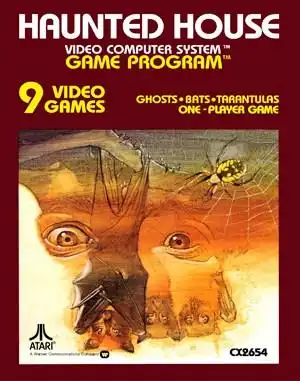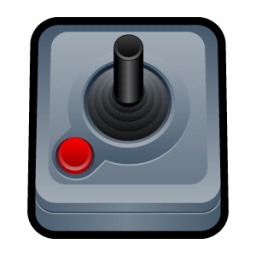The year is 1982. Halloween is approaching, and on the shelves of toy stores and electronics departments sits a little black cartridge promising pixelated chills. This wasn't a gore-fest or a jump scare simulator; this was Haunted House Atari 2600, a game that proved you didn't need high-fidelity graphics to create a spooky atmosphere.
With just a few pixels and some eerie sound effects, Atari challenged players to navigate a dark, monster-filled mansion. It might look incredibly simple by today's standards, but for many early gamers, this was their first taste of digital dread.
Stepping (or Floating?) into the Spooky Mansion
Forget detailed character models. In Haunted House Atari 2600, you control a pair of disembodied eyes. That's it. Just two little white squares floating through the gloom. Your mission is deceptively simple: find three pieces of a magic urn scattered throughout the sprawling, 24-room mansion and bring them back to the entrance.
Sounds easy? Think again. The mansion is dark, full of locked doors, and patrolled by things that go bump in the digital night.
More Than Just Eyes: Gameplay Mechanics
Navigating this haunted abode requires more than just floating around. The core mechanics are simple but effective for the era:
- Matches: The mansion is mostly dark. You carry matches that you can light to briefly illuminate the room you're in. This is crucial for seeing items, doors, and, most importantly, enemies. But matches are limited, adding a layer of resource management.
- Inventory: You can only carry one item at a time. This means tough choices. Do you carry a match? A piece of the urn? The key to a locked door? Or maybe the scepter that offers some protection? Swapping items means dropping what you have to pick up something else.
- The Mansion: It's a multi-story affair with one-way doors, forcing you to learn the layout and sometimes take circuitous routes.
Ghouls, Ghosts, and Creepy Crawlies
You're not alone in the mansion. Several types of creatures want to stop your quest, and touching any of them costs you one of your nine lives:
- Vampire Bats: Flutter around erratically.
- Tarantulas: Skitter across the floor.
- The Ghost: The most persistent threat, often phasing through walls on higher difficulties.
These enemies, represented by simple sprites, managed to be surprisingly menacing thanks to the dark environment and the tension of trying to avoid them.
Turning Up the Fear: Difficulty Settings
One of the great things about many Atari 2600 games, including Haunted House, was the use of difficulty switches and variations. Haunted House featured nine different variations that could drastically change the experience:
- Room lighting levels (from fully visible to almost completely dark).
- Introduction of locked doors requiring a key.
- More enemies or faster enemies.
- Enemies with special abilities (like bats stealing your item).
- The effectiveness of the scepter item.
These variations offered significant replayability and allowed players to tailor the challenge, from a mild stroll through a slightly spooky house to a terrifying crawl in pitch blackness.
A Spooky Legacy: Why Haunted House Matters
Upon release, Haunted House was a solid seller and often compared to Atari's earlier hit, Adventure. Many reviewers praised its unique atmosphere and sound design, noting how effectively it used the limited hardware to create tension. While some found its blocky graphics and initial lack of clarity frustrating, those willing to learn its rules found a challenging and rewarding game.
Interestingly, Haunted House Atari 2600 is sometimes cited as one of the very earliest precursors to the survival horror genre. While it lacks complex narratives or intricate puzzles of later games like Resident Evil, the elements are there: limited resources (matches, lives), navigating a dangerous environment, avoiding powerful enemies, and a pervasive sense of vulnerability. It might not fit the modern definition perfectly, but it certainly tapped into that feeling of being hunted in a dark, confined space.
The game's impact is clear, having been included in numerous Atari compilations over the years, appearing on everything from the PlayStation 2 and Nintendo DS to modern PCs and consoles in the Atari 50: The Anniversary Celebration. It even spawned follow-up games decades later, a testament to the original's memorable concept.
Finding Your Way Back: Where to Play Today
Want to experience this piece of retro gaming history? While finding an original Atari 2600 and cartridge might be a fun hunt, the easiest ways include:
- Atari Compilations: Look for titles like Atari Anthology or Atari Greatest Hits on various platforms. The recent Atari 50 collection is also an excellent option.
- Emulation: Projects like Stella allow you to play Atari 2600 games on modern computers. Archive.org also hosts many classic games playable in your browser.
FAQ
- Is Haunted House Atari 2600 actually scary? For its time, yes, it was atmospheric and tense due to the darkness and limited lives. By modern standards, it's more "spooky" and nostalgic than truly terrifying.
- How many rooms are in the mansion? The mansion has 24 rooms spread across four floors.
- What does the scepter do? The scepter can deter most enemies, but the ghost is often immune, especially on higher difficulty settings.
- Is it related to the board game? No, it's a completely original video game concept by Atari.
Conclusion
Haunted House Atari 2600 remains a fascinating artifact of early video game design. It took a simple concept – a spooky mansion, hidden items, and dangerous monsters – and implemented it effectively within the severe technical constraints of the Atari 2600. It’s a game that relied on atmosphere and tension rather than graphical fidelity, proving that sometimes, all you need are a pair of eyes, a few matches, and something scary lurking just out of sight to create a memorable experience. It's a must-play for anyone interested in the roots of adventure games or the early sparks of digital horror.


